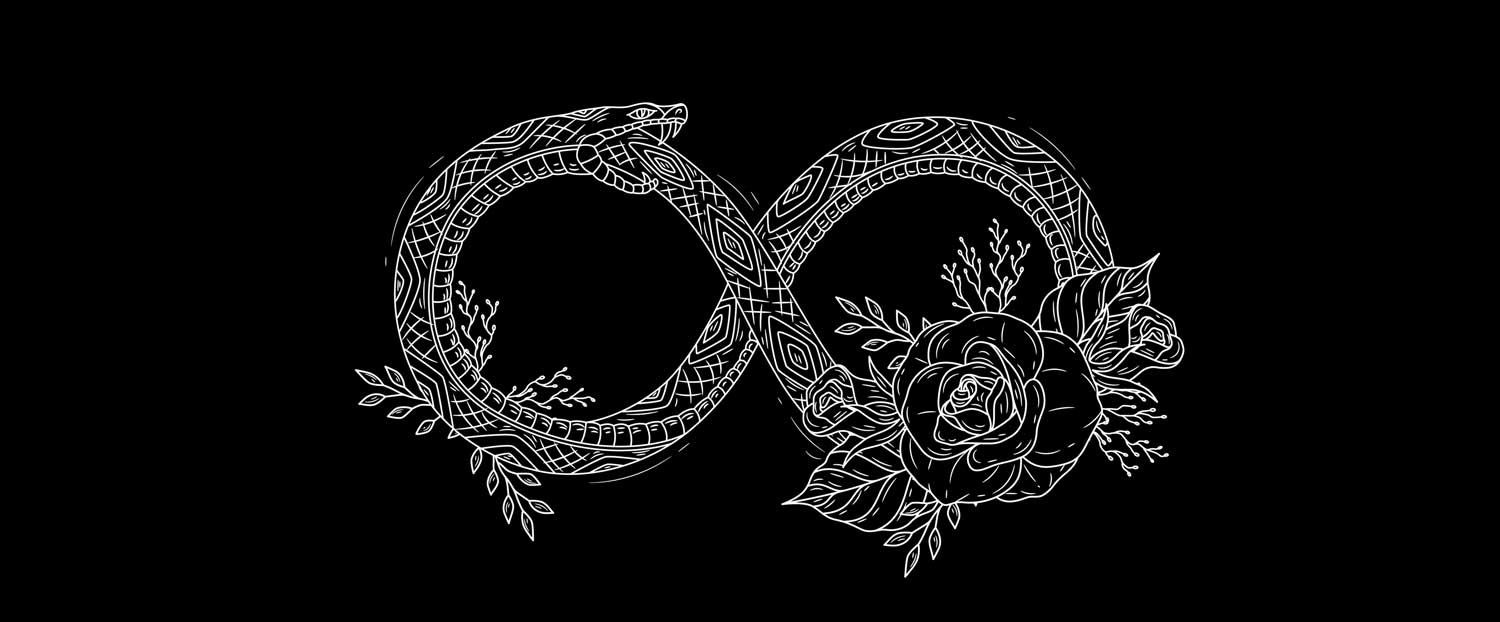
Ouroboros meaning and origins
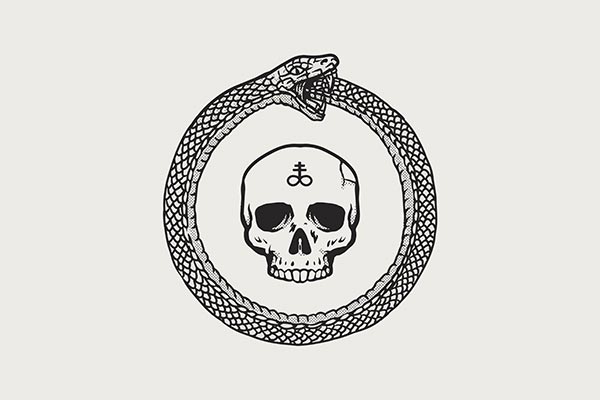
Ouroboros meaning and origin
The ouroboros symbol, often depicted as a snake eating its tail to form a circle, is one of the oldest and most recurring motifs in the mythology and iconography of various cultures around the world. Next, I will tell you about some of the most notable origins and meanings of ouroboros in different cultures:
-
Ancient Egypt: One of the first known records of the ouroboros comes from ancient Egypt, where it was associated with the serpent Uraeus, a protective deity represented as a cobra. Ouroboros was related to the cycle of life, death and renewal, and was often found in amulets and funerary jewelry. It was also linked to the idea of eternity and the unity of time.
-
Ancient Greece: In Greek mythology, the ouroboros is sometimes associated with the serpent Ladon, who guarded the Garden of the Hesperides and is often depicted as a serpent eating its own tail. This symbol is related to the idea of constant regeneration and the infinite cycle of nature.
-
India: In Hindu tradition, the ouroboros is found in the image of the Ouroboros Ananta Shesha, the cosmic serpent that supports the god Vishnu as he floats in the cosmic ocean. This snake represents eternal time and the infinite cycle of creation and destruction in the universe.
-
Alchemy: During the Middle Ages and Renaissance, the ouroboros became an important symbol in alchemy. It represented the union of opposites, such as the masculine principle (the Sun) and the feminine principle (the Moon), and symbolized transmutation and the search for the philosopher's stone, which conferred immortality.
-
Other cultures: The ouroboros also appears in Chinese mythology, where it is known as the "Jade Dragon." Additionally, it is found in Mesoamerican cultures such as the Aztec, where it is associated with the feathered serpent Quetzalcoatl.
The general meaning of the ouroboros is the idea of an eternal cycle, renewal, the unity of opposites and eternity. It is also interpreted as a symbol of self-reflection and self-transcendence, where the individual seeks understanding and wisdom by exploring their own limitations and potentials.
Overall, the paradox of the ouroboros challenges our conventional understanding of time, renewal, and the relationship between opposites. It invites contemplation and reflection on the interconnectedness of all things and the complex nature of existence. The paradox inherent in the symbol has made it a powerful and enduring motif in various cultures and philosophical traditions.
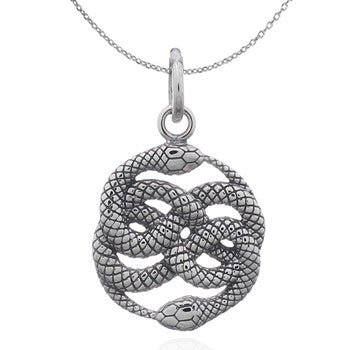
In summary, the ouroboros is an ancient and universal symbol that has evolved throughout human history and culture, representing profound concepts related to the cyclical nature of life and the pursuit of wisdom and transcendence. His legacy endures to this day as a reminder of the richness and depth of human symbolic thought.
What does Ouroboros stand for?
The word "uroboros" or "ouroboros" has its origins in ancient Greek terms. It is made up of two Greek words:
- "Oura" (οὐρά): Means "tail" in ancient Greek.
- "Boros" (βόρος): Means "eat" in ancient Greek.
Therefore, "uroboros" or "ouroboros" would be literally translated as "he who eats the tail."
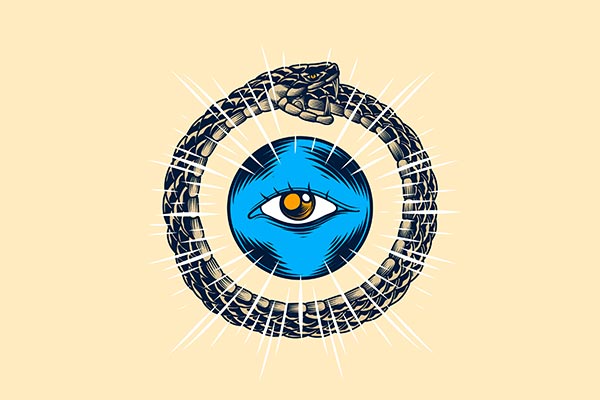
Ouroboros spiritual meaning
The spiritual meaning of the ouroboros varies depending on tradition and interpretation, but in general, this ancient symbol is associated with several deep spiritual concepts. Here are some common interpretations of the spiritual meaning of ouroboros:
-
Rebirth and Eternal Cycle: The ouroboros symbolizes the idea of an eternal cycle of life, death and rebirth. It represents the notion that life and energy never completely die, but are constantly transformed and renewed in an infinite cycle. This can be interpreted spiritually as an affirmation of the immortality of the soul or as an invitation to embrace the process of change and transformation in life.
-
Union of Opposites: The ouroboros can also represent the union of opposites, such as yin and yang in Chinese philosophy. By showing a snake eating its own tail, the symbol suggests that opposite extremes are connected and cannot exist without each other. This can be interpreted as a reminder of the need for balance and harmony in spiritual life.
-
Self-Reflection and Self-Transcendence: The ouroboros can be seen as a symbol of self-reflection and self-transcendence. By looking inward and exploring our own limits and potentials, we can achieve greater spiritual understanding and a higher level of consciousness. The snake eating its own tail may represent the idea of seeking truth and wisdom within oneself.
-
Eternity and Unity: The ouroboros can also be interpreted as a symbol of eternity and unity. By forming a closed circle, the symbol suggests the idea that everything is interconnected and that time is circular rather than linear. This can inspire a sense of oneness with the cosmos and an understanding that we are part of something larger and more lasting.
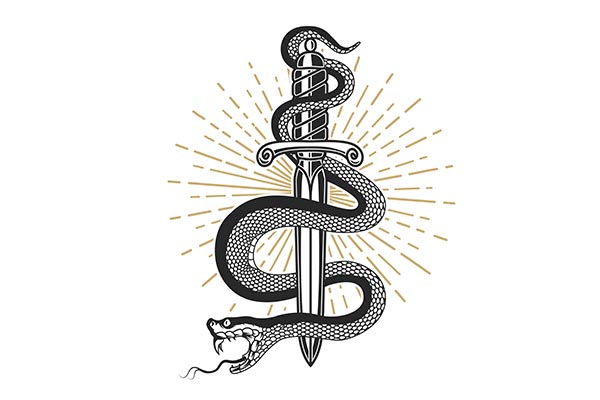
What meaning did the snake have for the Vikings?
The snake had various meanings and symbolism in the mythology and culture of the Vikings and other Norse peoples. Here I present some of the most relevant interpretations and meanings:
-
Jörmungandr (The World Serpent): In Norse mythology, Jörmungandr was a gigantic serpent that surrounded the known world, biting its own tail in a circle, similar to the ouroboros symbol. He was one of the three children of Loki and Angrboða. Jörmungandr symbolized chaos and destruction and was destined to trigger Ragnarök, the end of the world, when he finally let go of his tail and faced Thor.
-
Snakes in Navigation: The Vikings were known as expert sailors and explorers. On their travels, they often encountered sea serpents, which could be interpreted as signs of good or bad luck. Depending on the circumstance, they could be associated with protection or danger at sea.
-
Snakes as Symbols of Power: In some Viking runic inscriptions and engravings, snakes are depicted, often along with other animals and symbols. It is believed that these representations could have been symbols of power or status, although their exact meaning is often ambiguous and can vary depending on context.
-
Snakes as Guardians: In Norse mythology, it was believed that snakes could be guardians of treasures or sacred places. Some stories say that the Vikings faced guardian snakes in their search for wealth or knowledge.
-
Snakes as Representations of Nature: In Norse cosmology, the natural world was full of beings and spirits, and snakes could have been considered manifestations of nature and its mysteries.
It is important to note that the exact interpretation of the snake in Viking culture can vary depending on context and region. Furthermore, information about Viking beliefs and symbolism comes mainly from later written sources, as the Vikings did not leave a large amount of written records about their religious beliefs and practices. As a result, some of these interpretations may be speculative and based on Norse mythology recorded in the Poetic Edda and Prose Edda, as well as runic inscriptions and archaeological finds.
What gods are associated with ouroboros?
The ouroboros, often symbolizing concepts like cyclicality, eternity, and the unity of opposites, has been associated with various gods, deities, and mythological figures in different cultures and traditions. Here are a few examples:
-
Apep (Apophis): In ancient Egyptian mythology, Apep (also known as Apophis) was a serpent deity associated with chaos and destruction. Apep was often depicted as a giant serpent or dragon, and it was believed to try to devour the sun god Ra as he traveled through the underworld at night. The image of Apep shares similarities with the ouroboros in terms of a serpent or dragon biting its own tail, symbolizing the cyclical struggle between chaos and order.
-
Jörmungandr: In Norse mythology, Jörmungandr, also known as the Midgard Serpent, is a monstrous serpent that encircles the world, biting its own tail. Jörmungandr is one of the children of Loki and is foretold to play a significant role in the events of Ragnarök, the Norse end-of-the-world scenario. Its association with the ouroboros reflects themes of cyclical destruction and renewal.
-
Ouroboros in Alchemy: While not a specific deity, the ouroboros is a prominent symbol in alchemy, where it represents the philosopher's stone, a substance believed to grant immortality and transform base metals into gold. In this context, the ouroboros symbolizes the cyclical process of transformation and the pursuit of spiritual and material perfection.
-
Quetzalcoatl: In Aztec and other Mesoamerican mythologies, Quetzalcoatl, the Feathered Serpent, is a deity associated with wind, creation, and fertility. While Quetzalcoatl is not directly linked to the ouroboros, the serpent imagery is significant in Mesoamerican cultures, and serpents are often associated with creation and cyclical processes.
These associations highlight the diverse ways in which serpent or dragon symbolism, often resembling the ouroboros, has been integrated into the mythologies and belief systems of various cultures. While not all of these figures are directly equivalent to the ouroboros, they share themes related to cycles, transformation, and the interplay of opposing forces, which are central to the symbolism of the ouroboros.
jewelry in trend
The latest jewelry for women
2 colors available
1 color available
2 colors available


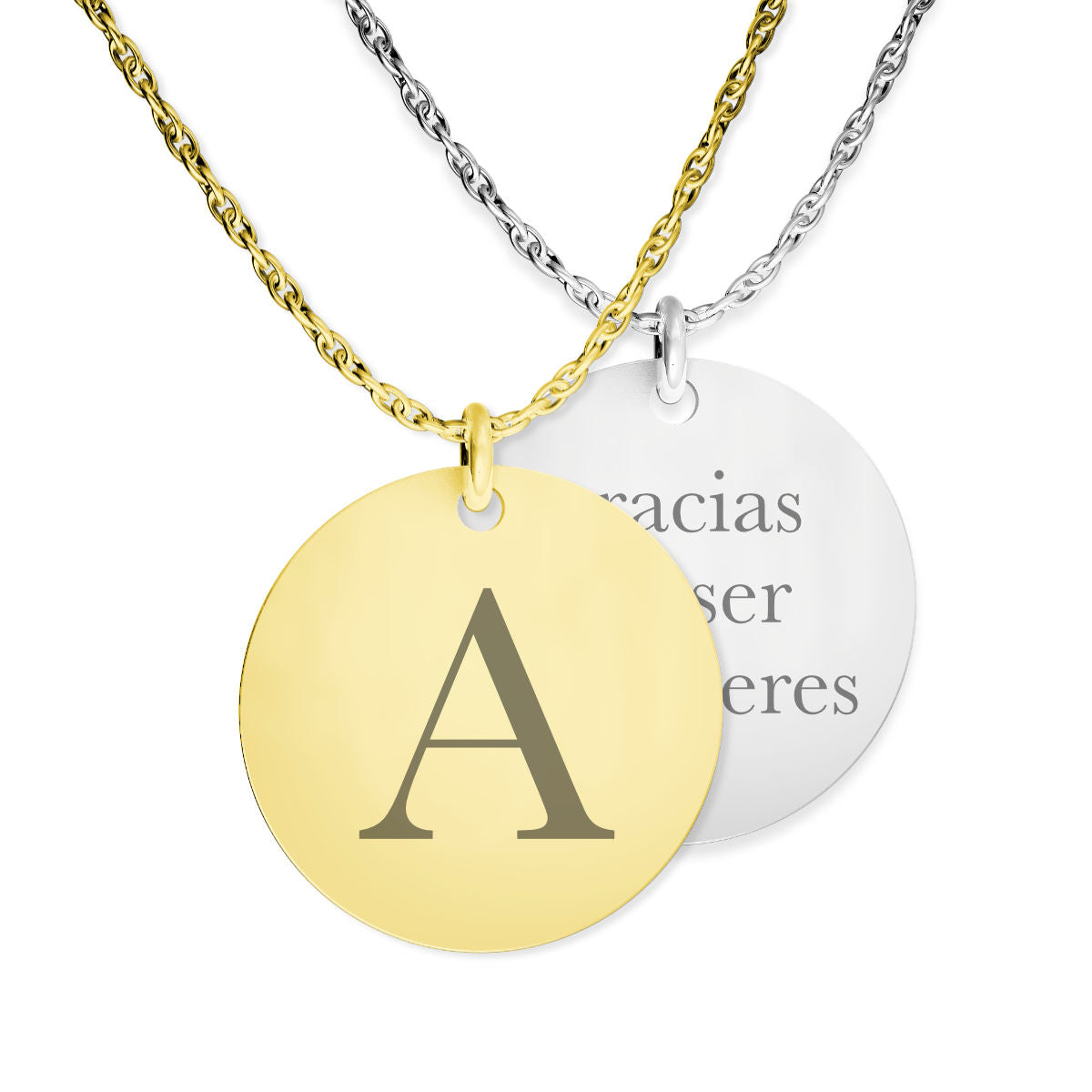











Leave a comment
This site is protected by hCaptcha and the hCaptcha Privacy Policy and Terms of Service apply.